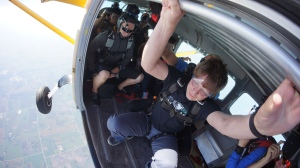(Some names have been changed.)
That Sunday the Tanabatas came and picked us up in their white car, a carriage which would quickly become very familiar. We sat in the back with Kanako who, though quiet, didn’t seem too perturbed to have to share the back seat with two tall Americans who happened to be her teachers. We headed to church, and Heidi talked with the Tanabatas in her cheerful, loving way. Somehow she could talk to them in English and they could understand, but whenever I tried to say anything, it took but a few moments before they would turn to Heidi, who would translate by rephrasing what I had just said, at which point Tanabata-san would nod, understanding perfectly. I looked on, bewildered as to what I was doing wrong.
I was very nervous entering the Shin-Shimonoseki church, where we doffed our shoes in the genkan and pushed our socked feet into slippers—the proper inside footwear. The church slippers, though, are designed to fit Japanese feet, which they do quite well. I, however, do not possess Japanese feet. Thus, I wedged my elephantine American perambulators into the minuscule footwear, my heels sticking off the backs, and trod uncomfortably into the sanctuary, the slippers shifting about underneath my weight.
The church was small, the outside resembling a quaint country church, and the inside housing some twenty church members. People smiled at me, but few approached, although the pastor, a man named Kawaguchi, introduced himself as I limped about on the slippers, and I was handed a translation of his sermon rendered in English, for which I thanked him before sitting down.
I didn’t get to sit with Heidi; she played the piano, while Mrs. Tanabata and Kanako sang along to help lead worship. I sat alone, trying to follow the songs, which were mostly familiar but sung in Japanese. I had been told I could sing in English, and encouraged to belt out the music however I felt comfortable. Yet to sing in English seemed inharmonious with the Japanese words, as if I was singing an entirely different song while the congregation trilled away in their native tongue. I didn’t know the Japanese lyrics, but they were projected on a screen, and most were written in hiragana, which I had already studied, so I could sort of read it. I followed along as best I could, stumbling over the syllables, pausing frequently as I tried to decipher the next character. It wasn’t very worshipful, never mind reverential, but I wanted badly to praise in Japanese, not just because everyone else was doing it like some sort of international peer pressure system, but because I loved the sound of the language itself. Trying to concentrate on the words, I quickly found myself exhausted from straining to understand.
After a lull in the music, suddenly the announcer, the pastor’s wife, looked at me and said something, to which I likely gave an expression akin to a fifth grader when confronted with an equation in quantum physics. Heidi quickly explained that they were asking me to read the Bible verse that the pastor would be speaking on, flipping pages quickly through her Bible to assist me. The worship leader lady looked at me with kind expectation. Finally I found the words, and my tongue, and I read, self-consciously, slowly, but I’ve no idea now what verse it was. I wonder if I knew at the time.
The English-translated sermon didn’t prove to be much easier to understand than the music. It was machine-translated, meaning that Pastor Kawaguchi had written the sermon in Japanese, and then someone had run it through a computer program to translate it into English, which resulted in the occasional halfway coherent sentence amidst a marsh of garbled language. With my brain already mostly composed of rice gruel, many of the jumbled English sentences were quite near impenetrable, although I had to admit, all that mental processing necessary in deciphering what the pastor was saying certainly made me look at those old familiar texts in a slightly different light.
As Heidi had warned me in advance, after the church service concluded, there was the time of announcements—which included an announcement of me, introducing me to the congregation. I heard the worship leader say my name with her thick Japanese accent—“Neekorasu Dorisukoru”—and then I had to stand for the congregation’s appraisal and say a few words, wave, bow, and so on. I must have spoken a little Japanese, to which they reacted with pleased surprise—a response I would quickly discover was common, no matter how poor my Japanese might be. I didn’t say much, but after I was done those assembled broke out in applause. I sat down, blushing.
Then it was back into the social maelstrom. People wanted to talk with me, but no matter how slowly or how carefully I spoke, they didn’t understand. Rather, the usual response was for them to look at me with head slightly cocked to one side and a little grin on their faces, maybe pretending to understand but obviously failing to comprehend much. Then Heidi might come over, and they could understand her perfectly, even though she would usually talk in speedier English than I would. I didn’t get what the problem was. I didn’t know how to choose the particular English words that they could understand, or what particular grammatical structures they would be most familiar with. Nor did I understand the way to speak with precise pronunciation and confidence that would facilitate conversation, nor had I deduced the big part that familiarity and friendship can play in communication. I left church that day in a swirl of frustration, reprimanding myself for my failures, wishing that I knew how to do something right.

